In the world of steel pipe manufacturing, Electric Resistance Welded (ERW) pipes have become a cornerstone of various industries. These pipes, known for their strength, versatility, and cost-effectiveness, play a crucial role in applications ranging from oil and gas transportation to structural support in construction. This article delves into the intricacies of ERW pipes, exploring their welding mechanism, manufacturing process, and the materials and sizes available in the market.
|
|
|
Welding Mechanism
The electric resistance welding process is a fascinating blend of electrical and mechanical engineering. At its core, this method utilizes the principle of electrical resistance to join metal surfaces. When an electric current passes through two metal pieces in contact, it generates heat at the junction due to the resistance offered by the metal. This heat, combined with pressure, creates a solid-state weld without the need for additional filler material.
In ERW pipe production, the process begins with a flat steel strip or skelp. As the strip is gradually curved into a cylindrical shape, its edges are brought together. At this point, copper contact wheels apply a high-frequency electrical current to the edges. The resistance of the metal to this current causes localized heating, bringing the edges to a temperature just below the melting point. Simultaneously, pressure rollers squeeze these heated edges together, forcing out any impurities and creating a forge weld.
One of the key advantages of this welding mechanism is its efficiency. The process is continuous, allowing for high-speed production of long pipe sections. Moreover, the weld quality is generally consistent throughout the length of the pipe, contributing to the overall reliability of ERW pipes.
It's worth noting that the ERW process has evolved significantly since its inception. Modern high-frequency welding techniques have largely replaced the older low-frequency methods, resulting in improved weld quality and reduced heat-affected zones.
Manufacturing Process
The manufacturing process of electric resistance welded steel pipes is a well-orchestrated sequence of steps designed to ensure quality and efficiency. Let's walk through this process:
- Material Preparation: The process begins with the selection of high-quality steel coils. These coils are inspected for quality and then uncoiled and leveled.
- Edge Milling: The edges of the steel strip are precisely milled to ensure a clean, square edge that will facilitate proper welding.
- Forming: The flat strip is gradually formed into a tubular shape using a series of rollers. This step is crucial in determining the final diameter of the pipe.
- Welding: As described in the welding mechanism section, the edges of the formed tube are brought together and welded using high-frequency electric current and pressure.
- Weld Bead Treatment: Immediately after welding, the weld bead (the raised area of metal along the weld) is typically treated. This can involve trimming excess material or heat treatment to normalize the weld area.
- Sizing and Straightening: The welded pipe passes through sizing rolls to ensure it meets the exact diameter specifications. It's then straightened to remove any curvature.
- Heat Treatment: Depending on the intended application, the pipe may undergo heat treatment to achieve specific mechanical properties.
- Testing and Inspection: Various tests are conducted to ensure the pipe meets quality standards. These may include hydrostatic testing, ultrasonic testing, and visual inspections.
- Finishing: Finally, the pipes are cut to the required length, and end treatments (such as beveling) are applied if necessary.
This manufacturing process allows for the production of high-quality ERW pipes with consistent properties along their entire length. The continuous nature of the process also contributes to its cost-effectiveness, making ERW pipes an economical choice for many applications.
Materials & Sizes
Electric resistance welded steel pipes are available in a wide range of materials and sizes, catering to diverse industry needs. The choice of material and size depends on factors such as the intended application, operating conditions, and regulatory requirements.
Materials:
ERW pipes are typically manufactured using various grades of carbon steel or low-alloy steel. Some common material specifications include:
- ASTM A53: This specification covers black and hot-dipped galvanized welded and seamless steel pipe. Grade B is commonly used for ERW pipes.
- API 5L: This standard from the American Petroleum Institute covers pipe for use in oil and gas pipelines. ERW pipes can be manufactured to various grades within this specification, such as Grade B, X42, X52, X60, and others.
- ASTM A500: This specification is for cold-formed welded and seamless carbon steel structural tubing in rounds and shapes.
- EN 10219: This European standard covers cold-formed welded structural hollow sections of non-alloy and fine grain steels.
The choice of material grade depends on factors such as strength requirements, corrosion resistance needs, and operating temperatures.
Sizes:
ERW pipes are available in a wide range of sizes to suit various applications. The size of an ERW pipe is typically defined by its outside diameter and wall thickness. Common size ranges include:
- Outside Diameter: ERW pipes can be manufactured with outside diameters ranging from as small as 1/4 inch (6.35 mm) to as large as 24 inches (610 mm). However, the most common range is between 1/2 inch (12.7 mm) and 20 inches (508 mm).
- Wall Thickness: The wall thickness of ERW pipes can vary significantly, typically ranging from Schedule 10 to Schedule 160. In metric measurements, this could be anywhere from about 2 mm to 20 mm or more, depending on the pipe diameter and application requirements.
- Length: Standard lengths for ERW pipes are often between 20 feet (6 meters) and 40 feet (12 meters), but custom lengths can be produced based on specific project needs.
It's important to note that while ERW pipes can be produced in larger diameters, sizes above 24 inches are more commonly manufactured using other methods such as spiral welding or longitudinal submerged arc welding (LSAW).
The versatility in materials and sizes makes electric resistance welded steel pipes suitable for a wide array of applications, from water and gas distribution to structural supports in construction and industrial piping systems.
About Longma Group
Electric resistance welded steel pipes represent a significant advancement in pipe manufacturing technology. Their efficient production process, consistent quality, and wide range of available materials and sizes make them a popular choice across numerous industries. From the intricate welding mechanism that ensures a strong, reliable joint to the comprehensive manufacturing process that guarantees quality at every step, ERW pipes continue to meet the demanding needs of modern infrastructure and industrial applications.
Longma Group product range features outer diameters from 1/4" to 20" (13.7mm to 508mm), wall thicknesses from SCH10 to SCH160 (6.35mm to 59.54mm), and lengths from 6m to 18m. We offer both beveled ends (BE) and plain ends (PE) to suit your specific requirements. Don't miss the opportunity to enhance your projects with our high-quality steel pipes. Contact us now at info@longma-group.com to explore how we can be your reliable partner in steel pipe solutions.














